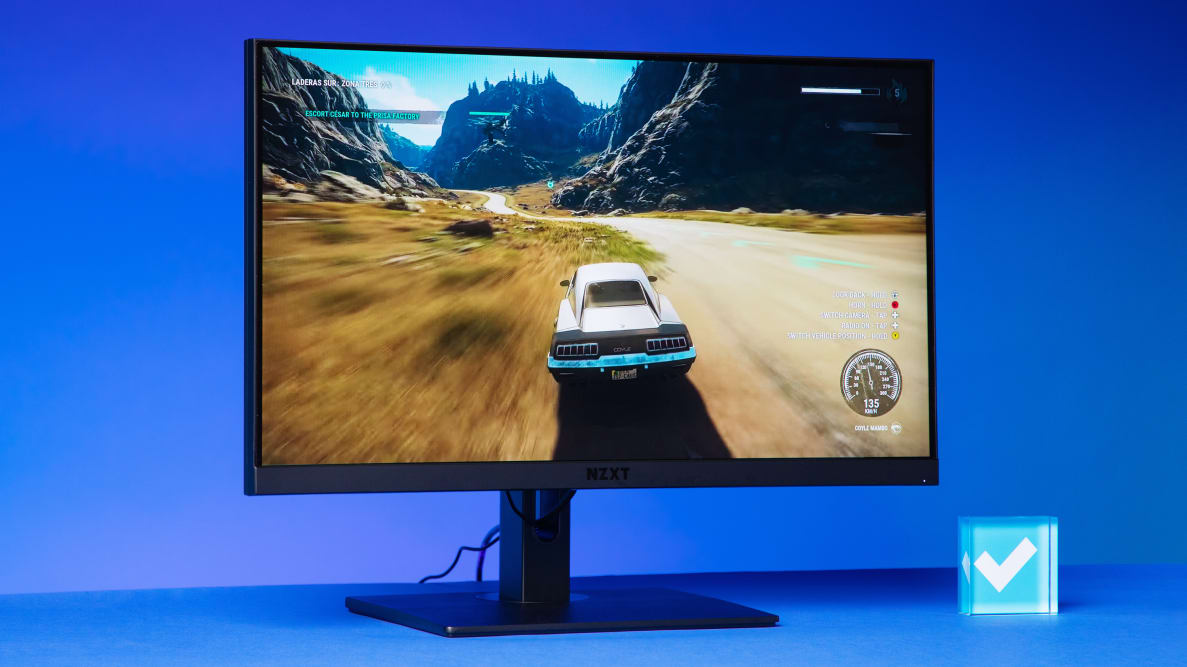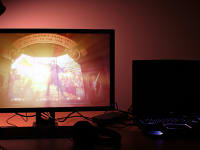Pros
-
Just the right size for 1080p
-
An abundance of ports
-
Super fast speeds
Cons
-
Barebones HDR
-
Mediocre black levels
-
Poorly calibrated out of the box
About the NZXT Canvas 25F
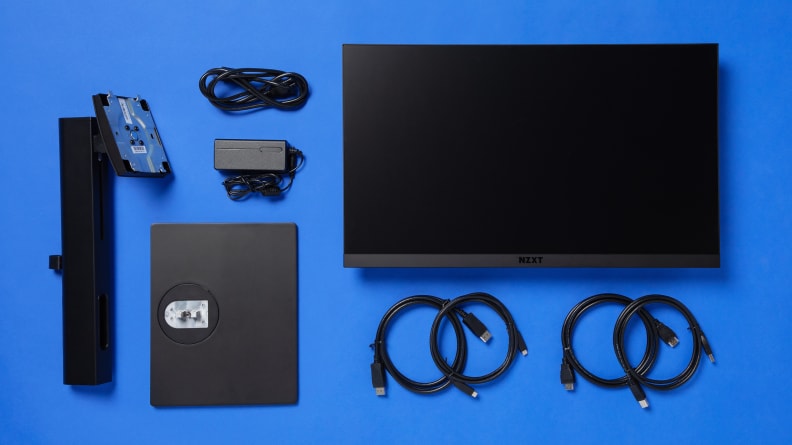
All of the contents included with the NZXT Canvas 25F.
Here are the specs of the gaming monitor we tested:
- Price: $210 (panel only), $250 with monitor stand
- Display size: 24.5 inches
- Resolution: 1920 x 1080 pixels
- Refresh rate: 240Hz
- Peak brightness: 400 nits (rated), 417.19 nits (tested), 425.52 nits (in HDR mode)
- HDR support: VESA DisplayHDR 400
- Color depth: 8-bit
- Color saturation: 89% DCI-P3, 99% sRGB (rated); 84.6% DCI-P3, 99.8% sRGB (tested)
- Contrast ratio: 1000:1 (rated), 1047:1 (tested), 853:1 (in HDR mode)
- Pixel response time (GtG): 1ms
- Ports: 2 x HDMI 2.0, 1 x DisplayPort 1.2, 1 x USB-C/DP alt (video in) , 2 x USB-A 3.0 (down), 1 x USB-B 3.0 (up), 1 x 3.5mm
- VRR Support: AMD FreeSync Premium, G-Sync compatible
- Other features: VESA mount
Continuing NZXT’s favored design philosophy of offering sleek PC components in white or black, like the company’s Lift mouse or computer cases, the Canvas 25F’s panel is available in either color. If you opt for a stand, it can be either black or white and mixed and matched with the panel separately. You can also bundle a monitor arm in for $100 more, or a dual monitor arm for $170.
A 27-inch version of the Canvas 25F with otherwise identical specifications, the Canvas 27F, is also available starting at $230 but has gone on sale for as low as $175. It shouldn’t be confused with the Canvas 27Q, a 27-inch, 1440p monitor that tops out at 165Hz. All models lack speakers.
What we like
The convenient size and snazzy design
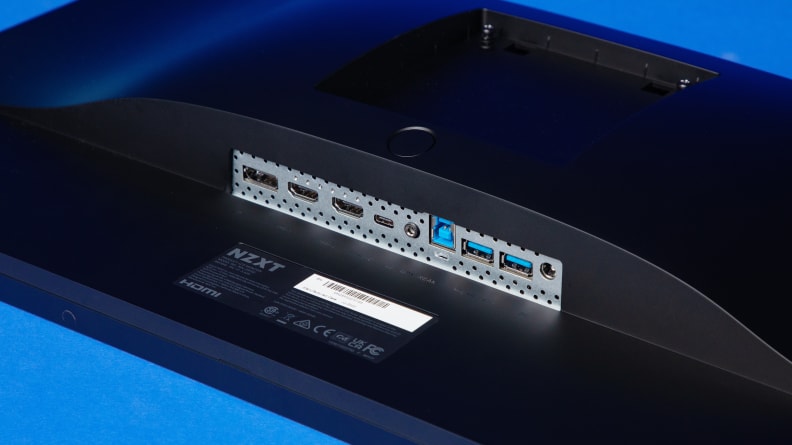
You'll have a lot of connectivity options with this monitor.
The NZXT Canvas 25F hits what I would call the sweet spot for 1080p monitors. At 24.5 inches, text is still legible without looking stretched, and you should have enough screen space for most productivity tasks, barring large spreadsheets.
Anything larger will look blurry due to the low pixel density, and anything smaller may make text and other fine details difficult to see. This is why I personally wouldn’t recommend picking up a 1080p, 27-inch gaming monitor.
The Canvas 25F knocks it out of the park design-wise, too. It retains the same sleek lines, thin bezels, and navigation joystick on the back as the larger Canvas 27Q, and it could easily be mistaken for a business monitor from afar. It’s not likely that someone will ever see the back of the Canvas 25F unless you’re in an open-plan office or set it up in the living room, but the attention to detail is appreciated. NZXT has also labeled each port so you can see where to plug your cables in without having to tilt the panel itself (or guess).
If you want to just plug everything in and forget about it, NZXT CAM allows you to control everything from the monitor’s brightness to color settings from an onscreen program. It’s a bonus if you’re already tied into NZXT’s ecosystem, but not a killer feature.
The stand is the same model paired with the Canvas 27Q. It’s robust, has an integrated cable routing passthrough, and the perforated holes running up the spine are a fun flourish, but it’s not worth an extra $40. It can tilt, swivel, and pivot 90 degrees, but so will most monitor arms.
Fast speeds that don’t blur
A 240Hz refresh rate is something that most gamers don’t need, but unlike the 1440p Gigabyte M27Q X, it will be much easier to hit that speed at the Canvas 25F’s max resolution. You won’t need an RTX 4090 to take advantage of what this monitor has to offer.
Of course, a high refresh rate doesn’t necessarily translate into a smooth gaming experience. Even the fastest monitors with VA panels, like the 240Hz Cooler Master GM27-CFX that costs twice as much, can have distracting motion artifacts and trails that lead off of fast-moving objects. Ghosting in high-contrast scenes and muddy colors due to low pixel response times can ruin an otherwise great monitor.
That isn’t the case with the Canvas 25F. Because it uses an IPS panel, the motion clarity and viewing angles are excellent. Whether it was chasing down enemies as Sojourn in Overwatch 2, hacking through wildlife with a lightsaber in Fortnite, or dashing through high heats in Hades, I never saw blur behind fast-moving objects.
The same was true in Blur Buster’s UFO test, where I could only detect three frames of movement ahead of and behind the UFO. That might seem like a lot, but at 240Hz, it’s nearly imperceptible in games. This kind of speed is intended mainly for esports players, and the Canvas 25F doesn’t disappoint there.
A wealth of connectivity
The Canvas 25F is pitched as a gaming monitor, but one addition sets it apart from similarly specced competitors: USB-C. The Alienware AW2521HF packs four USB 3.0 ports for $40 more, as does the $200 Lenovo Legion Y25-25, but both lack video-in via USB-C.
This might seem like a small quality-of-life feature, but being able to get full DisplayPort 1.2 speeds over USB-C is a boon for laptop users. My Steam Deck and M2 MacBook Pro were able to simultaneously put video out and charge via the same connector.
If you mainly use a laptop and are looking for a larger external monitor without having to get a dock, the Canvas 25F could be an elegant solution.
What we don’t like
Contrast and color are nothing special
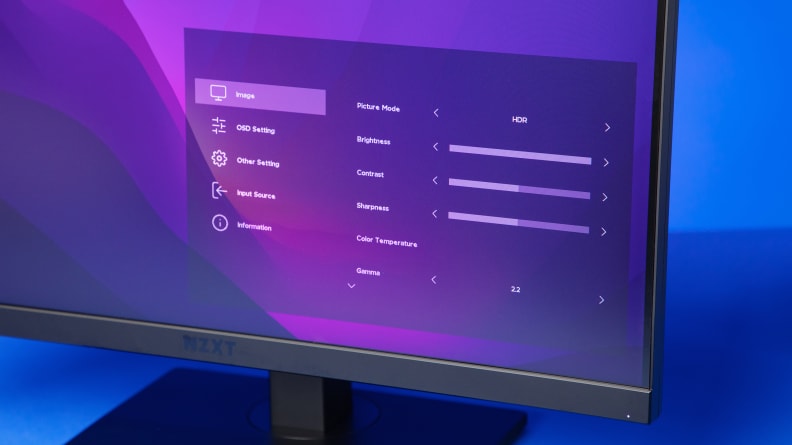
Do not expect a wealth of colors and ultra-clear imagery in the resolution.
Unfortunately, smaller high-speed IPS panels seem cursed with poor color coverage and contrast compared to their larger counterparts, and the NZXT Canvas 25F is no exception. It also doesn’t provide a great viewing experience straight out of the box.
On first boot, the monitor at factory settings was dim and much too warmly colored. Whites were trending toward yellow, and everything was a bit washed out. You should always color-calibrate a new monitor, but not everyone will, so having to fiddle with the settings right after unboxing the monitor was a bit disappointing.
Contrast is just alright, but it literally pales when placed next to a more expensive monitor. I measured a 1047:1 contrast ratio out of the box, which is pretty typical for an IPS display, but that number dropped to only 853:1 with HDR enabled. At least it’s bright, peaking at 417 nits in SDR mode and 425 nits with HDR turned on.
Color accuracy is where the Canvas 25F falters, even if it’s comparable to the Alienware AW2521HF. NZXT promises a DCI-P3 of 89%, but I repeatedly measured it at only 84.7%. sRGB coverage was measured at 99.8%, so NZXT was right on the money, but Adobe RGB coverage was measured at a paltry 74.8%. For comparison, the 27-inch, 1440p, 170Hz Gigabyte M27Q I use as my main monitor features DCI-P3 and Adobe SRGB coverage of over 92%, and it only costs $250.
In games, the color on the Canvas 25F is a little washed out, but it’s not noticeable to the point of distraction. And while there isn’t fringing or ghosting, the backlight bloom when bright objects are contrasted against a black background is detectable to the naked eye. Suffice it to say, don’t buy this monitor for creative work.
HDR isn’t worth enabling
For only $210, you’d likely expect the Canvas 25F’s HDR performance to be lacking, and you’d be correct. Although NZXT rates the Canvas 25F as VESA DisplayHDR 400 certified, I barely noticed a difference between HDR and SDR.
After watching HDR showcase content, movies, and playing games in both HDR and SDR, I have to conclude that there’s no reason to enable HDR on this monitor. On top of the drop in contrast ratio, you won’t get the broad range of realistic colors, darker blacks, and brighter highlights that good HDR implementation should provide. Like CAM, it’s nice that NZXT included the functionality, but don’t expect great HDR from any monitor under $500.
Should you buy the NZXT Canvas 25F?
Yes, especially if you already have a monitor arm
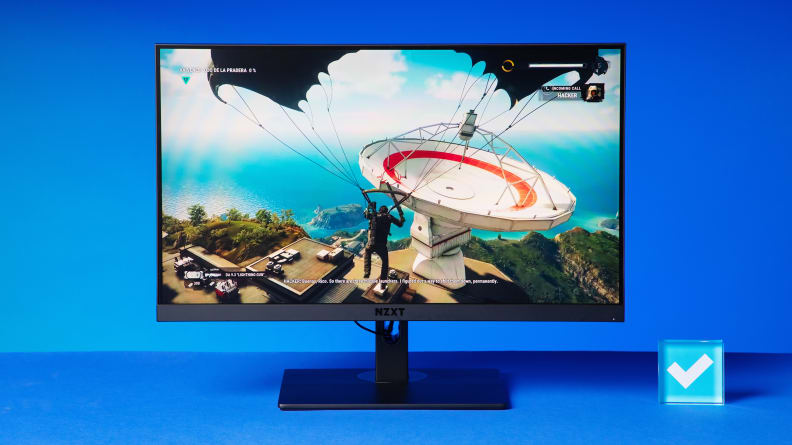
It's an excellent choice to connect your laptop to.
The NZXT Canvas 25F competes in a crowded market. There are plenty of good 1080p gaming monitors that can hit 240Hz nowadays for under $250, but the included USB-C connector and overall build quality puts the Canvas 25F ahead of the competition. If you skip the stand (which you should), you could snag a killer deal when the panel goes on sale.
For $250, the Alienware AW2521HF pairs more USB ports with comparable display speeds and Alienware’s controversial (and much thicker) styling. The Lenovo Legion Y25-25 is the Canvas 25F’s biggest competitor; it provides the same speeds at the same size for $10 less, but lacks a USB-C port and has worse color space coverage.
The elephant in the room is Gigabyte’s excellent G24F 2. It’s only 23.8 inches, and “only” hits a maximum speed of 180Hz, but also offers much better color accuracy and can be had for as low as $130. Therein lies the problem—most people don’t need a 240Hz monitor, and the differences between playing at 170Hz and 240Hz were minimal in my testing.
But if you want a solid all-arounder of a gaming monitor with a very high refresh rate that can seamlessly connect to your laptop, NZXT’s Canvas 25F fits the bill.
Meet the tester
Jonathan is an Electronics Editor for Reviewed specializing in gaming gear and has experience with everything from controllers to benchmarking the latest GPUs. He was previously the Web Editor at The Architect's Newspaper.
Checking our work.
Our team is here to help you buy the best stuff and love what you own. Our writers, editors, and experts obsess over the products we cover to make sure you're confident and satisfied. Have a different opinion about something we recommend? Email us and we'll compare notes.
Shoot us an email